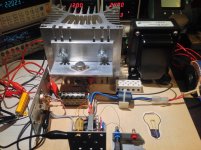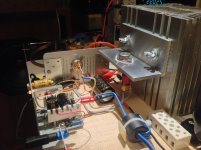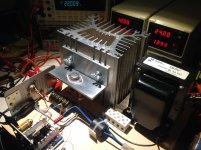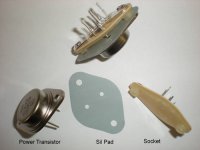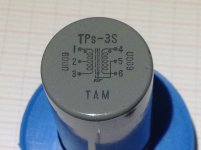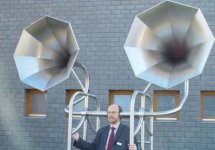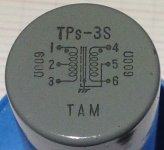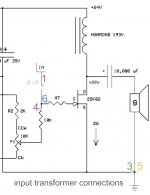Think of your bench supply as a battery. The bias (negative) supply will have its red terminal and green terminal tied together and the black terminal is your minus ref. Your B+ supply will be just the opposite. I'll be hanging around the lab tomorrow if you get into trouble 🙂
Guys, what voltage ripple do you get with the "official" L'Amp's supply?
I get 5mV positive "crests" ripple over flat background with my PowerReg regulated supply.
No hum (98dB woofers), no thump, though I wish it was flatter.
Cheers,
M.
I get 5mV positive "crests" ripple over flat background with my PowerReg regulated supply.
No hum (98dB woofers), no thump, though I wish it was flatter.
Cheers,
M.
Yes silver colour is the alnico 1255 Phillips 8 ohm's bi-cones.
What i like they are large 12''~30 cm not 8 ''
can play music without crossover contrary to coaxials.
You can find them at affordable price on the flea market.
What your Jensens reference ?
Me like that high quality old school audio model's.
Must go sleep now but tomorrow i do try how Phillips sound
with Inductor L'Amp prototype if all work correctly
Better than 300B ?
https://www.youtube.com/watch?v=JtibVx4_8Ms
I have been interested in Phillips, they must be good ones. My Jensen is nothing exotic, very common P15LL + RP horns. I only have gotten 1 set, so they are currently mono attached on OB. 🙂
Guys, what voltage ripple do you get with the "official" L'Amp's supply?
I get 5mV positive "crests" ripple over flat background with my PowerReg regulated supply.
No hum (98dB woofers), no thump, though I wish it was flatter.
Cheers,
M.
The common dual supply (CRC 4x0.47 ohm) without LC filter 15-20mV AC
The common dual supply (CRC 4x0.47 ohm) with additional LC filter 2.0-3.0mV AC
Measured at speaker terminal.
The common dual supply (CRC 4x0.47 ohm) without LC filter 15-20mV AC
The common dual supply (CRC 4x0.47 ohm) with additional LC filter 2.0-3.0mV AC
Measured at speaker terminal.
Good.
Thank you very much.
M.
I'll be hanging around the lab tomorrow if you get into trouble 🙂
Super Michael thanks
Back to bench my " island of peace " last wirings verifications,
lab psu's memory is hold now on -12V and the second + 24 V.
Dummy load 8 Ohm |50 watts resistor on the speaker output's ready connected too.
Check of the trimmer resistance...Hahaha excited a little

Attachments
intringuant l'ami !🙂 what is the red cylinder just under the VFet ? the yellow one seems a variable capacitor what is for?
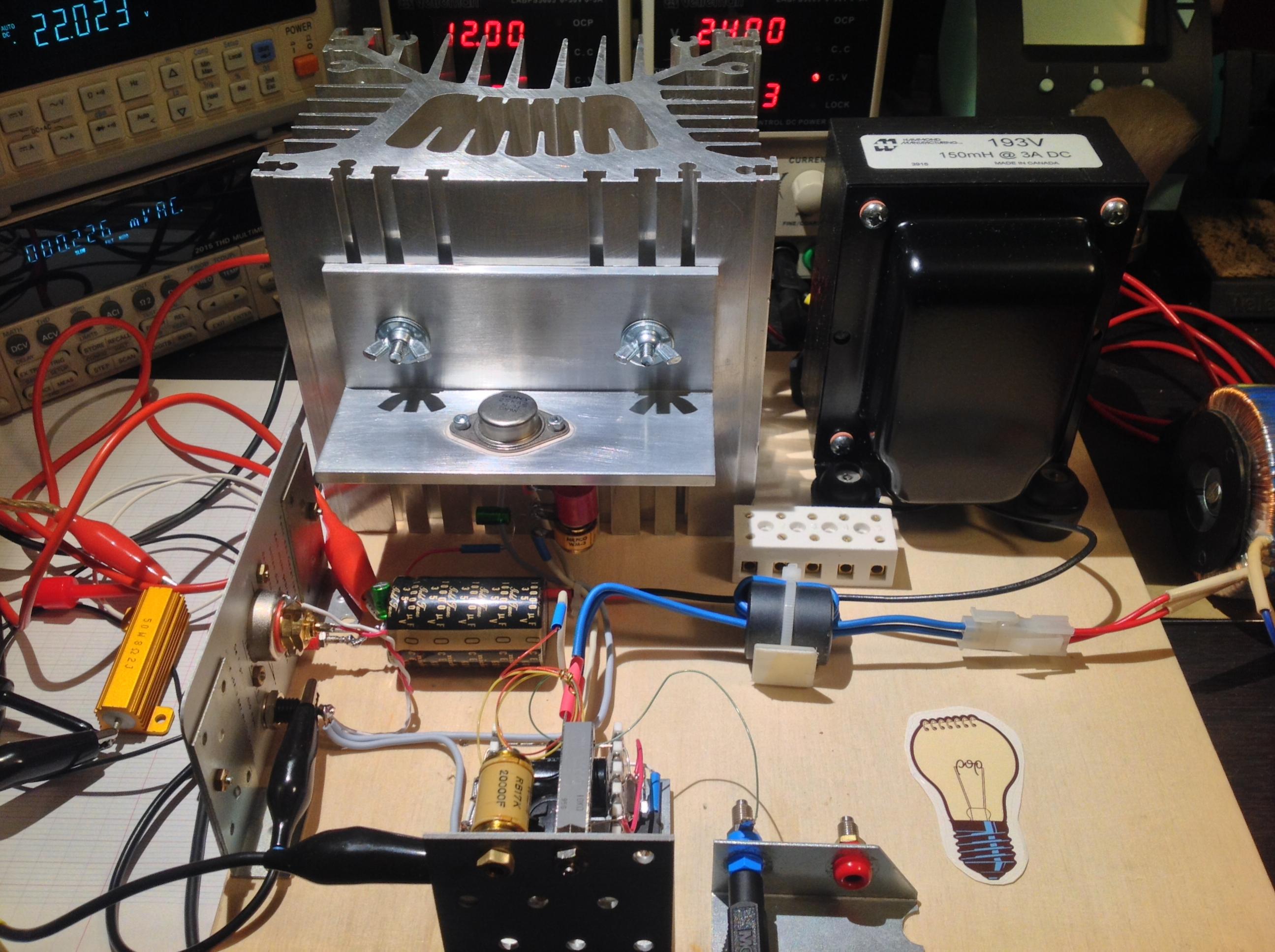

I thought I heard angels singing 🙂
Thank You very much sir Rothacher !
Thanks to Diyers for encouragements and councils.
Haha Yes Angels are visiting my listening room now.
Amplifier from the first start power on work like a charm.
Was sleepless night full of songs and many music hours today.
Trimming 22V from drain to ground was quick to find and after temperature stabilisation
i plug them with CD player , triode preamp and 12'' alnico full ranges.
Incredible nice voices and good surprise about bass .
Now i feel highly motivated to build final version monoblock's.
It's fun and bunch of satisfaction diy project

intringuant l'ami !🙂 what is the red cylinder just under the VFet ? the yellow one seems a variable capacitor what is for?
Haha i am always curious too and like share my findings.
Was interesting to do something i don't have ready made so
i try not use classic metal film resistors and the cermet trimmers this time.
Concept is 193V L'Amp with all wire wound Ayrton Perry
non-magnetic materials resistors and high quality wire wound trimmer 10K silver grey colour.
Red cylinder = 47 ohm's , yellow one are 10K and other is 2K in bias circuit.
All components the same like on original schematic : input cap 10uF is bipolar Muse
and electrochemical 10000 uF|35 V Nichicon Gold Tune bypassed with second green bipolar Muse.
For pleasure of experimenting to try other technology resistors my 2SK82 have place
into TO-3 socket i do not solder or desolder directly on his pins and keep them safe

Attachments
Connecting 600:600 input transformer on the place of 10uF is worth to try ?
Some wait in drawer. If yes how wire them for best performance , dot directions , (-)(+) any tips ?
Have a nice day 🙂
Some wait in drawer. If yes how wire them for best performance , dot directions , (-)(+) any tips ?
Have a nice day 🙂
Attachments
For primary hot point of the RCA to 1 and 3 to ground OK ?
Secondary 6 to vfet gate and 4, 5 to the ground ?
Secondary 6 to vfet gate and 4, 5 to the ground ?
Glad Plasnu your L'Amp work fantastic. Congratulations !
My is not finshed yet because i spend last week's all my hobby €$ budget on new drivers
and the next vintage 12'' full range alnico's pairs too.Full ranges are 98 dB.
Drivers have 102dB efficiency so i can enjoy flea watt's amplifiers use practicaly 1 watt and that plenty.
My Inductor 193V L'Amp project is for play music with this new efficient stuff
I think that vintage FR will not be able to produce low bass. why dont you limit with small input capacitor to create HPF on usable range? example with my SIT input impedance 24K and 100nF rusia teflon caps already filter below 60Hz, really reduce FR cone excursion. you can also use Vcap input 🙂 I also use this method for other FW clone.
but you must need bass support like FAST system, that's the beauty of biamp. SS class AB, D, or H for low and SIT for FR

Now i feel highly motivated to build final version monoblock's.
It's fun and bunch of satisfaction diy project
me too.
I'll go ahead and make another version with a single supply. 🙂
Last edited:
For primary hot point of the RCA to 1 and 3 to ground OK ?
Secondary 6 to vfet gate and 4, 5 to the ground ?
4 should be connected to Bias + 10K, otherwise no bias voltage on the gate. I'm curious which you like better, Transformer or Cap.
On the schematic they be like that ?4 should be connected to Bias + 10K, otherwise no bias voltage on the gate. I'm curious which you like better, Transformer or Cap.
Must be sure no ruin working amp with wrong wiring.
Yes with pleasure i write you what cap versus input transformer sonic difference is 🙂
Attachments
I think that vintage FR will not be able to produce low bass. why dont you limit with small input capacitor to create HPF on usable range? example with my SIT input impedance 24K and 100nF rusia teflon caps already filter below 60Hz, really reduce FR cone excursion. you can also use Vcap input 🙂 I also use this method for other FW clone.
but you must need bass support like FAST system, that's the beauty of biamp. SS class AB, D, or H for low and SIT for FR

Yes they not go far in low frequencies but for small acoustic band´s music like
classic with piano and quartet of strings, jazz and traditional folk music is sufficient.
Horn loaded 12'' FR is interesting solution and play all the music with only one single-ended SIT amplifier.
[DIY project] DIY Tannoy 12" Dual Concentric Horn
[DIY project] DIY 12" Goodmans Axiom 201 Horns
Choice of no bi-amplification and minimalism.
It's my hobby

- Home
- Amplifiers
- Pass Labs
- L'Amp: A simple SIT Amp



